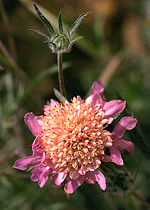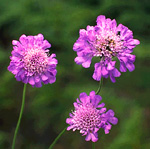 |
A small family from temperate Europe, Asia and Africa, all species of Dipsacaceae in Australia are introduced, originally as garden plants but some escaped and naturalised along roadsides and in disturbed areas in the temperate south.
Characteristic features of the family Dipsacaceae in Australia include: - annual or perennial herbs, usually rather rough-haired, with opposite or whorled, toothed or dissected leaves more or less sheathing the stem with at least partially fused margins
- flowers small but massed into daisy-like or thistle-like heads, tubular, more or less 2-lipped, usually purplish
- stamens 4; ovary inferior, forming small, dry fruits that are often bristly from the persistent calyx
Description
Biennial or perennial terrestrial herbs. Perennating by taproots or crowns. Vegetative reproduction by bulbils or proliferous flowerheads. Stems unarmed or with prickles or spines arising from the stem surface; internodes solid, spongy, pithy or hollow, terete, oval or slightly flattened. Internal secretions not obvious. Plants with simple, non-glandular, unicellular hairs. Leaves opposite, both basal and cauline, petiolate, subsessile or sessile and with pulvinae present. Stipules and stipellae absent. Lamina simple or once compound, unifoliolate, symmetric, pinnatifid or pinnatisect; lamina/leaflets lanceolate, ovate, oblanceolate or obovate; base cuneate or attenuate; margins entire or dentate or serrate, ±flat; one-veined, or the venation pinnate, with the midrib conspicuous or inconspicuous, and the tertiary venation not reticulate; surfaces not punctate; herbaceous. All the flowers bisexual. Inflorescences terminal or axillary, consisting of capitula, spikes or cymes. Bracts and bracteoles present. Pollination by insects. Flowers odourless; sessile or stalked. Floral disc present; nectaries present on the carpels or apparently absent. Perianth of at least 2 dissimilar whorls, or vestigial, or absent. Epicalyx present or absent. Calyx regular; segments fused, with 4–5 lobes, imbricate or valvate in bud; calyx cup-shaped or bell-shaped, herbaceous or papery. Corolla irregular; segments fused, with 4–5 lobes, alternating with the calyx lobes, imbricate in bud; corolla 1-lipped, white, pink, magenta or purple, without contrasting markings, membranous; claws absent; lobes ±entire. Fertile stamens 4, opposite to the calyx lobes, at least partly fused to the corolla, free of the ovary and style, distinct from each other, all ±equal. Anthers basifixed, versatile, opening sideways or inwards by longitudinal slits, 2-celled. Ovary inferior. Carpels 2, fused; ovary with 1 locule. Style terminal, single and branched above. Ovule 1, stalked; placentation apical. Fruit a dry, indehiscent cypsela; the perianth on the maturing fruit deciduous or dry and persistent. Disseminule macro-surface featureless or usually awned; micro-surface ±costellate, brown or grey, dull. Seeds 1 per fruit. Aril absent. Cotyledons 2. Embryo straight.
(Note: this description has been generated from the coded data compiled for the key. Any errors in the key data will be reflected in the descriptions.)
A treatment of the family Dipsacaceae has not yet been published in the Flora of Australia. It will appear in Volume 36.
Australian genera of Dipsacaceae (as recognised for the Flora of Australia)
* = all species introduced
*Dipsacus
*Scabiosa

|
  |

Scabiosa atropurpurea (flowers)
Photo: S.Jacobs © S.Jacobs

Scabiosa sp. (flowers)
Photo: K.Thiele © K.Thiele
|

| |